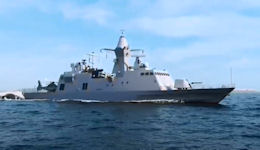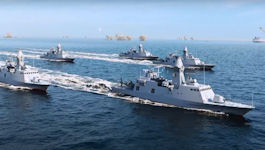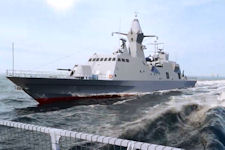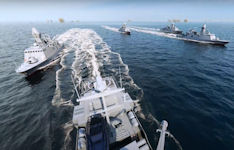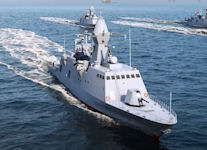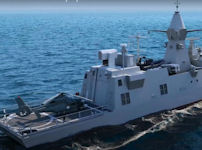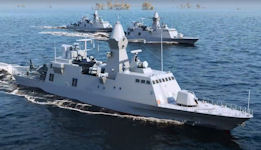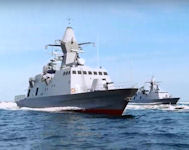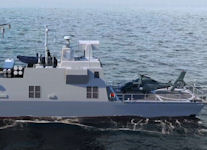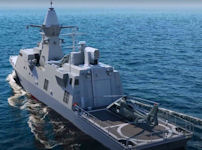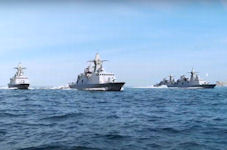UAENS Baynunah Corvette
The Baynunah class vessels are highly advanced 71 meter multi-mission corvettes that are fitted with cutting edge combat systems with the capability to perform a wide range of military operations, including defence against both air and surface threats. The Baynunah Corvettes are a unique class of warship with multi-mission capabilities, including coastal patrol and surveillance, mine detection and avoidance, helicopter operations, as well as anti-air and anti-surface capabilities. In performing these missions, Baynunah will utilize the very latest in weapons and sensor technology.
The ship is designed to provide Navies with a multi-role surface vessel capable of sustained operations throughout the GCC region. The vessels are designed to conduct peacetime patrols in their territorial waters and exclusive economic zones, together with surveillance, maritime interdiction, support to other forces, and the protection of coastline and ports. Steel constructed hull and deck, with superstructure fabricated from aluminium. Superstructure arrangement designed to minimise radar cross-section. The vessels will be the largest steel-hulled naval vessels ever built using water jets as their only means of propulsion. They will be powered by four diesel engines which will enable a speed in excess of 30 knots.
The combat system is centerd around a modern command and control system. The IPN-S will provide primary control of the major weapons systems while providing the ship's crew with a complete tactical picture combining information from ship's sensors, external communications, airborne sensors, and intelligence reports.
Primary ship sensors will include a three dimensional air search and a navigation radar with LPI capability. An EOMS infrared search and track weapons director will also be fitted. A Interrogation Friend or Foe (IFF) function for both radar sets will be provided. The electronic warfare suite will include laser electronics countermeasures systems, a radar electronic support measures system (ESM) and a electronic support measures and communications intelligence system will also be a part of the electronics warfare suite.
The primary anti ship weapons will be 2 x Missiles. The vessel's firepower is complimented with a single 76 mm main gun and two 27 mm side guns. The primary air defence system is centred on a vertical missile launcher system. This system will be controlled by the IPN-S combat control system a fire control system. Missile fire control will be supplemented by a continuous wave illuminator. The air defence missile system is augmented by a second set of surface to air missiles. These "fire and forget" missiles will be mounted on the weather fairing of the 27mm side guns.
All navigation system data will be collected and displayed through an Integrated Bridge system incorporating a laser gyro system for ship's reference and navigation. The integrated bridge system will include displays from the Navigation / LPI radar.
A complex network of integrated communications is provided and will include secure voice and data communications. This system will coordinate and provide communications and data sharing between the Baynunah vessels, other cooperating fleet vessels, land based command and control centers, and maritime patrol aircraft. The vessel will also be fitted with a CHAFF launcher decoy system and RAM system.
The UAE Government signed the original contract with Abu Dhabi Ship Building at the end of 2003 for the construction of four vessels. In July 2005, the Government exercised an option to order two additional vessels. The vessels are designed by Constructions Mechanique de Normandie (CMN) of Cherbourg, France, which is acting as a main subcontractor to ADSB for the design, as well as for the construction of the first vessel in France, technology transfer and supply of related logistics and training services. Since the signing of the original contract, ADSB, CMN and the UAE Navy have worked together to finalise the configuration of the ships, selected and ordered the main equipment, completed the preliminary design and completed the preliminary design of the combat systems.
The First of Class vessel is being built at CMN's Cherbourg yard under subcontract from ADSB and the remaining five will be built at ADSB's yard in Abu Dhabi. The biggest ever naval construction project in the Arabian Gulf Region was officially launched July 5 2006 with the keel laying ceremony of a Corvette at Abu Dhabi Ship Building (ADSB). The vessel is one of six being built by ADSB for the UAE Navy. The first part of the construction involves building blocks of steel structure that will be joined together at a later stage to form the hull of the vessel. In today's ceremony, Major General Al-Madani lowered a 23.7 meter block weighing 66 tonnes into position in the ADSB Assembly Halls. Designated C201, the block, which will be in a central position in the completed vessel, will contain machinery and engineering spaces for mechanical systems.
As the Baynunah program gathers pace, ADSB will be building five vessels simultaneously. Work on the second Corvette to be built in Abu Dhabi also began July 5 2006 when Major General Al-Madani pressed a button to start up the computer-controlled plasma cutting machine to begin cutting steel for that vessel.
The Saudi Arabian navy has embarked on a US$20 billion (Dh73.46bn)-plus expansion program and is said to be considering the purchase of up to a dozen new warships.
| Ship List | |||||||||
|---|---|---|---|---|---|---|---|---|---|
| Name | # | Builder/b> | Laid Down |
Launch | Comm | Decomm | Notes | ||
| P171 | Baynunah | Abu Dhabi Ship Building (ADSB) |
25 Jun 2009 |
11 Oct 2011 |
|||||
| P172 | Al Hesen | Abu Dhabi Ship Building (ADSB) |
22 Jul 2010 |
2012 | |||||
| P173 | Al Dhafra | Abu Dhabi Ship Building (ADSB) |
05 Apr 2011 |
2013 | |||||
| P174 | Mezyad | Abu Dhabi Ship Building (ADSB) |
16 Feb 2012 |
2014 |
|||||
| P175 | TBD | Abu Dhabi Ship Building (ADSB) |
2013 |
2015 |
|||||
| P176 | Al-Hili, | Abu Dhabi Ship Building (ADSB) |
08 Feb 2014 |
2016 |
|||||
| Displacement, full | 844-915 tons |
| Displacement, light | tons |
| GT (Gross Tonnage) | tons |
| NT (Net Tonnage) | tons |
| DWT (Deadweight) | tons |
| Length, O/A | 71.3-72 meters / feet |
| Length, W/L | meters / feet |
| Length, B/P | meters / feet |
| Max Beam | 11.3 meters / feet |
| Draft | 2.90 meters / feet |
| Height | meters / feet |
| Propulsion Type | Combined diesel and diesel (CODAD |
| Engines | 4 x MTU 12V595 TE90 diesel engines |
| Main RPM | |
| Main power | 4 x 4.2 MW each |
| Propeller(s) | 3 x Kamewa Waterjets models 112S11 and 125B11 |
| Speed, maximum | 30 knots |
| Speed, Cruise | 15 Knots |
| Range | 2,000 nm @ 15 knots |
| Stores endurance | 14 days |
| Electronics |
Sentry radar: Saab Microwave Systems Sea Giraffe AMB G-band Navigation radar: Terma A/S I band Scanter 2001 LPI radar Optronics: Sagem EOMS NG infrared search and track Jammers/Decoys: Saab Avitronics NLWS310 (laser warning) - Rheinmetall MASS ESM: Elettronica Seal Combat management system: Selex Sistemi Integrati IPN-S Weapon control system: Selex Sistemi Integrati NA-25XM Communications: Link 11 |
| Weapons Systems |
4x Raytheon Mk 56 dual-pack VLS (8x RIM-162C ESSM missiles) 1x Mk49 mod 3 Guided Missile Launcher (21x RAM block A1 missiles) 8x Exocet MM40 blk III 1x OTO Melara 76mm/62 (main gun) 2x Rheinmetall MLG 27 27mm |
| Aviation | 1 x Panther |
| Complement | 55 + 5 (including officers) |

|
NEWSLETTER
|
| Join the GlobalSecurity.org mailing list |
|
|
|



